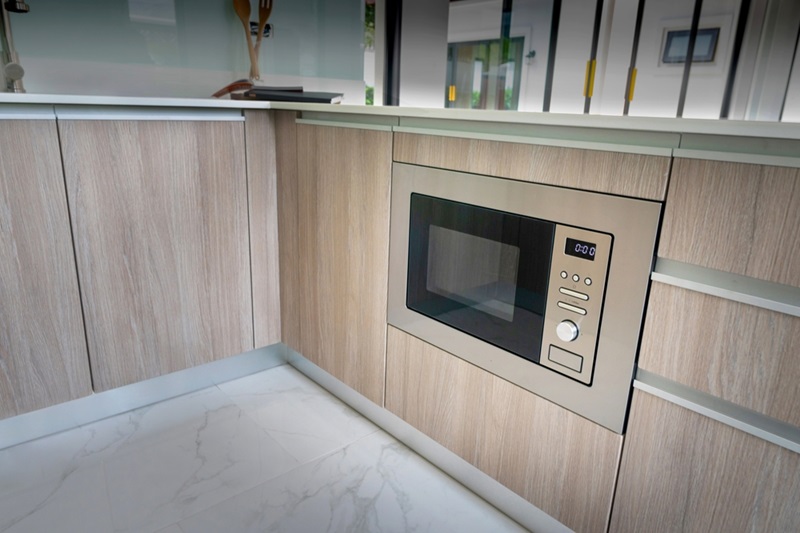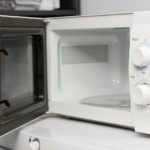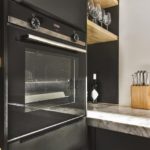Combination microwave ovens blend microwave speed with convection oven capabilities. But is it a worthy investment?
This article explores the space-saving design, diverse cooking functions, and real-world applications of combination microwaves, helping you decide if this kitchen appliance aligns with your cooking needs.
Join us as we take a deep dive into the advantages and disadvantages of this versatile kitchen appliance and answer the question: Is a combination microwave worth it?
What Are the Benefits of a Combination Microwave Oven?
A combination microwave oven, also known as a convection microwave oven, offers the benefits of both a traditional microwave and a convection oven.
Here’s a closer look at some advantages of these versatile kitchen appliances:
1. Versatility
Combination microwave ovens can perform a variety of cooking tasks. They can be used for basic microwave functions, such as reheating and defrosting, as well as for baking, grilling, and roasting with the convection feature.
This versatility makes them suitable for a wide range of cooking requirements—they’re an all-in-one kitchen solution!
2. Speed of cooking
Combination microwaves are known for their speed in cooking or reheating food compared to traditional microwaves and microwave ovens, as they rely on two technologies:
- Microwave technology: Microwaves use electromagnetic waves to directly heat the water molecules in food. This process is very efficient for tasks like, and is particularly fast in heating the outer layers of food.
- Convection cooking: Convection ovens, whether standalone or part of a convection microwave, use a fan and heating element to circulate hot air around the food. This creates a more even cooking environment and speeds up the cooking process.
When you combine these two technologies in a convection microwave, you get the benefits of both.
The microwave function rapidly heats the food’s surface, while the convection function ensures even cooking throughout. This allows for faster cooking times compared to using either method alone.
3. Improved energy efficiency
Using a combination microwave oven for specific cooking tasks can be more energy-efficient than using a conventional oven.
For example, the microwave function uses less energy than preheating a full-size oven when reheating or defrosting.
Meanwhile, the convection function speeds up the cooking process, lowering energy consumption.
Some combination microwaves even come with energy-saving features, such as sensor cooking technology that automatically adjusts cooking times based on the moisture content of the food.
These features can contribute to more efficient energy use and lower calculated electricity costs.
4. Take up less space
Combination microwave ovens save space in the kitchen by combining multiple functions into one appliance.
You have all the multi-functions of a full-size oven and a microwave compacted into one countertop appliance that takes up minimum space.
They are especially useful in smaller kitchens or apartments where you’re tight on space.
5. Multi-stage cooking
Many combination microwaves offer multi-stage cooking, allowing you to switch between microwave, convection, and grill modes seamlessly. This feature is handy for recipes that require different cooking methods at various stages and automates the process.
Convection microwaves thus provide a convenient way to automate complex cooking tasks. This feature is particularly helpful for recipes that involve a combination of microwaving, baking, roasting, grilling, and other cooking methods.
It allows you to use various cooking techniques without constantly monitoring and adjusting the settings.
6. Crisp and brown food
One of the main drawbacks of reheating dishes in a traditional microwave is that your food can get a little soggy.
Microwaves are designed to heat food quickly but aren’t well-suited for creating a crispy texture on the exterior!
Combination microwaves solve this issue entirely. The convection and grill features in combination microwave ovens allow for browning and crisping of food.
This is particularly useful for preparing dishes like casseroles, pizzas, and baked goods that benefit from a crispy exterior.
However, they might not achieve the same level of crispiness that you’d get in a dedicated oven.
7. Preprogrammed settings
Some combination microwave ovens come with preprogrammed settings for specific types of food, making it easier to achieve great results without having to guess cooking times and temperatures.
For example, you might find settings specifically for cooking pizza, popcorn, potatoes, and vegetables.
Most combination microwaves also come with preprogrammed settings for specific cooking needs. These depend on the make and model but include settings such as:
- Defrost setting: Many convection microwaves have a defrost setting that allows you to thaw frozen food quickly and safely. You can input the weight or time needed for defrosting, and the combination microwave does the rest.
- Reheat setting: This setting is optimised for reheating leftovers like stir-fries, pasta dishes, and leftover takeaways. It adjusts the cooking time and power level to prevent overcooking or uneven heating.
- Sensor cooking: Some advanced convection microwaves feature sensor cooking technology. These microwaves use sensors to detect how much moisture is in the food and adjust the cooking time and power level accordingly.
8. Easy to clean
Many combination microwave ovens have features such as removable turntables and non-stick interiors, making them easier to clean compared to traditional ovens.
Some modern combination microwaves also come with steam-cleaning features. These features use steam to loosen and soften food particles, making it easier to wipe away stains.
9. Quick preheating
The convection feature in combination microwave ovens often allows for faster preheating times compared to conventional ovens, saving you time in the kitchen.
Some microwaves even have advanced features, such as “rapid preheat,” to accelerate the preheating process further.
That said, the wattage of the microwave is a significant factor. Microwaves with wattages in the range of 800 to 1200 watts are common, with higher wattages typically providing quicker preheating times.
If quick preheating is a priority, consider looking for a combination microwave with a higher wattage and features designed to speed up the preheating process.
10. Combination cooking
Combination microwaves allow you to combine two or more cooking methods (microwaving, baking, and grilling or broiling) during the same cooking cycle.
For example, you might use the microwave and convection functions together to quickly cook and brown a casserole or the microwave and grill functions to reheat and crisp a slice of pizza.
Combination cooking offers the benefits of both speed (from the microwave) and browning capabilities (from the convection and grill functions), providing more flexibility in preparing a range of recipes.

What Are the Disadvantages of a Convection Microwave Oven?
While combination microwave ovens offer many benefits, it’s important to note that they may not replace a full-size oven for specific cooking tasks. Here are some of the disadvantages to consider:
1. More expensive
Generally, combination microwaves tend to be more expensive than basic, standalone microwaves.
This is because combination microwaves offer additional cooking features, such as convection and grill functions, which can increase their complexity and versatility. The cost of repairs and maintenance may also be higher.
2. Added complexity
While combination microwaves have many additional features compared to traditional microwaves, they are generally designed to be user-friendly.
However, the combination of microwave, convection, and grilling features can make the appliance complex to use.
Due to the combination of cooking methods, there may be a learning curve. You may find it challenging to navigate the various functions, especially if you are unfamiliar with convection cooking.
Reading the user manual is essential for understanding the specific features and functions, and achieving the desired results may require some experimentation with settings and cooking times.
3. Require more countertop space
While convection microwave ovens are more compact than traditional ovens, they may still take up more counter space than a basic microwave. This can be a disadvantage in smaller kitchens with limited space on the countertop.
However, the size of convection microwaves can vary significantly based on the specific model and brand, so you should be able to find an appliance appropriate for your kitchen. For example:
- Compact models: Compact combination microwave ovens typically have a capacity of around 0.5 to 1.0 cubic feet. These smaller models suit individuals or small households with limited kitchen space.
- Mid-size models: Mid-size convection microwaves often have a capacity ranging from 1.1 to 1.5 cubic feet. These microwaves provide a balance between capacity and counter space, making them suitable for average-sized kitchens.
- Full-size models: Full-size convection microwaves can have a capacity of 1.6 cubic feet and above. These larger models are well-suited for families or individuals who do a substantial amount of cooking in the microwave but require a larger amount of space.
4. Limited capacity
When considering the size of a convection microwave, it’s essential not only to account for the external dimensions to ensure that the microwave fits into your kitchen setup—you must also consider the interior cooking space.
Even for full-sized models, the interior capacity of convection microwave ovens is generally smaller compared to traditional ovens.
This can be a limitation when cooking large meals or batches of food, especially for big families.
However, the limited capacity could be an advantage if you have a small household or are cooking individual portions.
5. Heavier appliances
Convection microwave ovens are generally heavier than standard microwaves due to the additional components required for convection and grilling.
On average, they weigh from around 10 kg for compact models up to about 20 kg for full-size models. This makes them less portable and more challenging to move around your kitchen.
6. Noisier operation
Compared to traditional ovens, microwaves – including combination microwaves – tend to be quieter.
However, combination microwaves make more noise when using the convection and grilling functions compared to the noise of a standard microwave oven. This is due to the operation of the convection fan and heating element.
The noise level can vary among different models, but it is generally not considered excessively loud. However, you may find it bothersome if you’re sensitive to noise.
7. Not a full replacement for ovens
While convection microwave ovens are incredibly versatile, they are not a one-to-one replacement for a dedicated convection oven or grill. The main differences include:
- Heat distribution: Traditional ovens often offer more even heat distribution and control over temperature settings than combination microwave ovens.
- Number of racks: Dedicated ovens have a larger capacity with multiple racks, while double ovens have two separate compartments for cooking food simultaneously at different temperatures. Combination microwaves only consist of one smaller compartment.
- Browning and grilling: While combination microwaves can grill to some extent, ovens with grills are also better at browning and crisping than combination microwaves.
Therefore, cooking certain dishes – such as roasting large joints of meat, crisping the top of a pasta bake, or cooking a roast dinner with many oven-baked elements – may only be possible when using a traditional oven and grill.
Is It Worth Getting a Combnation Microwave?
Whether it’s worth getting a convection microwave depends on your cooking needs, preferences, and lifestyle.
While they may be more expensive upfront, they can offer added value and versatility in the kitchen, especially if any of the following sound like you:
- You’re looking for a space-saving alternative to a traditional oven. For those with limited kitchen space, a convection microwave provides a space-saving solution by combining the functions of a microwave and a convection oven in one appliance.
- You want to prepare tasty meals quickly. The combination of microwave and convection cooking allows for quicker cooking times, making them suitable for busy individuals or families who need to prepare meals in a hurry.
- You often cook using a variety of different methods. If you regularly use a variety of cooking methods (reheating, baking, roasting, and grilling), you may find a convection microwave versatile and convenient.
- You’re looking to find more energy-efficient cooking methods. Convection microwaves are often more energy-efficient than traditional ovens, as they require less time to preheat and cook delicious recipes.
- You live by yourself and frequently prepare meals for one. Smaller households may find convection microwaves suitable for their needs. The compact size and versatility make them well-suited for preparing meals in smaller quantities.
It’s important to note that while convection microwaves offer many advantages, they aren’t “worth it” for everyone. The decision to choose a convection microwave should align with your individual needs.
If budget is the only consideration holding you back, it’s a good idea to compare prices, features, and customer reviews to find a combination microwave that fits both your cooking needs and your budget.
Prices can vary substantially based on the brand and the specific features offered, so it doesn’t need to hold you back from efficient and effortless cooking.

Hannah is a freelance content writer and self-proclaimed foodie. When Hannah isn’t sitting tapping at her laptop, you’ll probably find her in the kitchen. As an ex-chalet host, she’s used to cooking four-course meals for 10+ people and loves feeding friends and family whenever possible.







